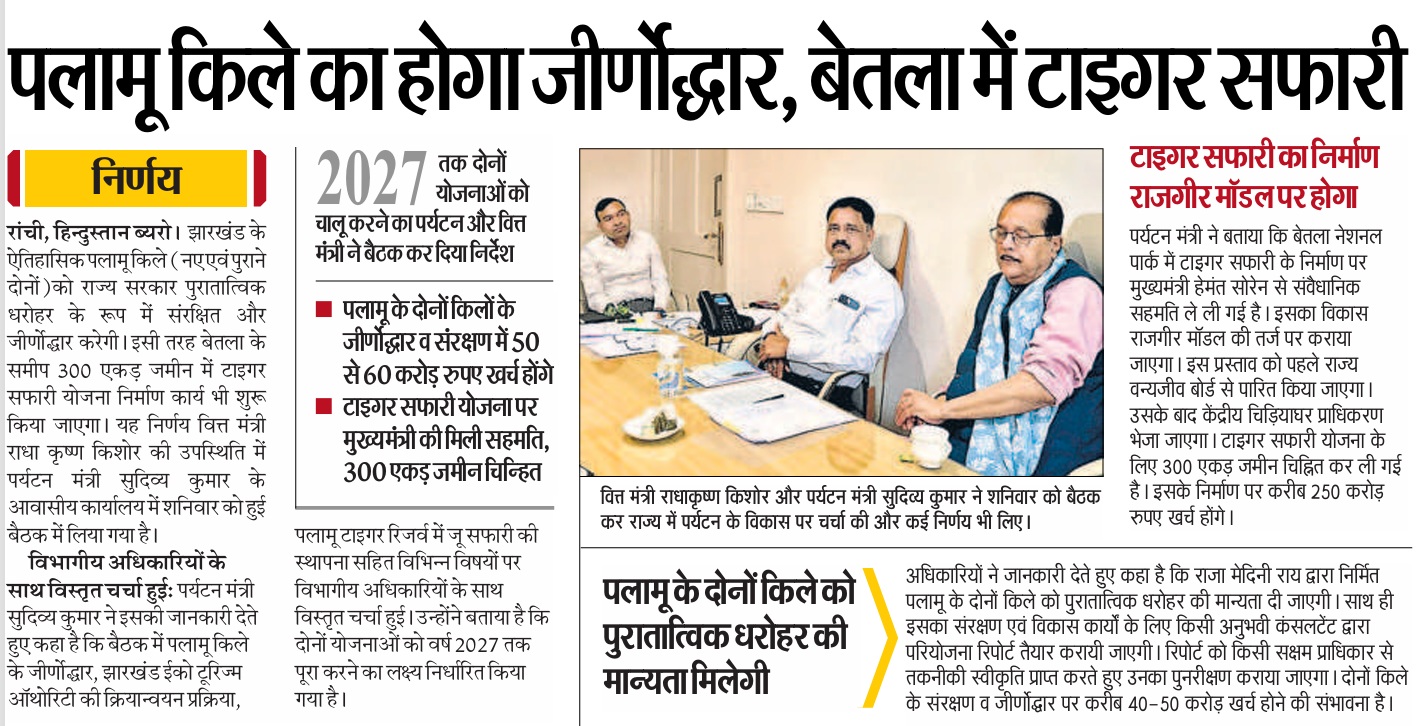The Palamu Fort and Tiger Safari project in Jharkhand is more than just infrastructure—it’s a blend of heritage restoration, eco-tourism, and economic development. The state government, in collaboration with the Archaeological Survey of India (ASI) and Indian Trust for Rural Heritage and Development (ITRHD), has launched this ambitious project to revive a 400-year-old fort and build a state-of-the-art tiger safari in Betla National Park.
The total estimated investment? ₹300 crore, with completion targeted by 2027.
Palamu Fort: 400-Year-Old Legacy Under Revival
The Palamu Fort complex comprises two forts:
-
Old Fort: Built by Pratap Rai (Chero Dynasty) between 1628–1658
-
New Fort: Built by Medini Rai between 1658–1674
These architectural marvels are nestled within the Palamau Tiger Reserve. The forts showcase intricate carvings and massive structures like the Nagpuri Gate (40 feet high, 15 feet wide).
🛠️ Ongoing Restoration Activities
-
Survey work initiated by ITRHD
-
DPR (Detailed Project Report) preparation in progress
-
Estimated restoration cost: ₹50–₹60 crore
-
Partnership with ASI and Jharkhand Forest Department
Once restored, the forts will be formally declared archaeological heritage monuments, protected under state law.
Betla Tiger Safari: A ₹250 Cr Eco-Tourism Venture
Located within Betla National Park, which is part of the Palamau Tiger Reserve, the Tiger Safari is planned over 300 acres and modeled after Rajgir Safari in Bihar.
🌿 Safari Project Details
-
Location: Betla, Latehar District, Jharkhand
-
Area: 300 acres
-
Budget: ₹250 crore
-
Model: Rajgir Tiger Safari
-
Target Completion: By 2027
-
Land Acquisition: Completed
-
Approval: From CM and State Wildlife Board; to be forwarded to the Central Zoo Authority
The project aims to offer controlled tiger viewing, conservation education, and increase footfall to over 10 lakh visitors annually once operational.
Historical and Cultural Significance
The Chero Dynasty forts are a rare blend of military defense, Hindu-Muslim architectural fusion, and strategic hilltop placement. Once part of Mughal military campaigns (including one led by Daud Khan), the fortifications symbolize resistance and regional pride.
Nagpuri Gate serves as the entrance to the new fort and is a testament to the artistry of that era.
🔍 Key Features
| Element | Description |
|---|---|
| Builders | Pratap Rai & Medini Rai (Chero dynasty) |
| Era | 1628–1674 |
| Location | Inside Palamau Tiger Reserve |
| Structures | Watch towers, ramparts, gates, temples |
| Preservation Need | Weathered walls, overgrowth, lost carvings |
Execution Timeline and Funding
| Component | Timeline | Budget Estimate |
|---|---|---|
| Palamu Fort DPR | By Aug 2025 | ₹50–60 crore |
| Tiger Safari Build | 2025–2027 | ₹250 crore |
| Total Budget | – | ~₹300 crore |
Funding Source:
-
State Government allocations
-
Forest Department reserves
-
Central Zoo Authority grants (for the Safari)
Impact on Tourism & Local Economy
The combined heritage and wildlife tourism strategy will have major socio-economic impacts:
💡 Benefits
-
Employment Generation: Eco-guides, park staff, vendors
-
Tourism Boost: Cultural & wildlife circuits for tourists
-
Local Business Growth: Homestays, handicrafts, transport
-
Youth Engagement: Jobs in tourism, hospitality, conservation
-
Educational Value: Promotes conservation and history awareness
The restoration and safari development are aligned with Jharkhand’s larger eco-tourism and heritage preservation policy.
Conclusion
The Palamu Fort and Tiger Safari project is not just a revival of Jharkhand’s rich past, but a giant leap towards an eco-conscious future. By 2027, Jharkhand is poised to emerge as a top destination for history buffs, wildlife lovers, and eco-travelers, thanks to this ₹300 crore public-heritage project.
With community participation, expert-led execution, and strong political will, Palamu’s forgotten glory will soon rise again.



